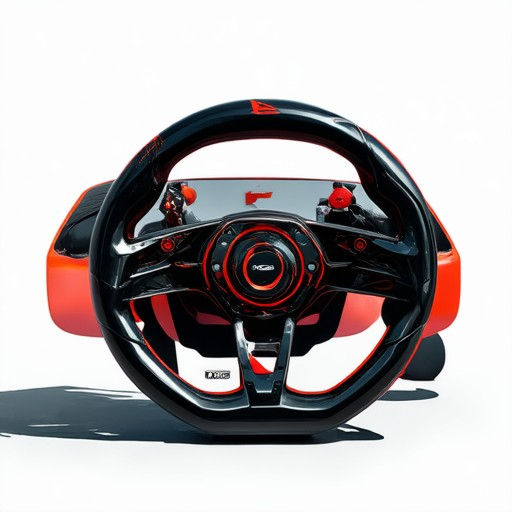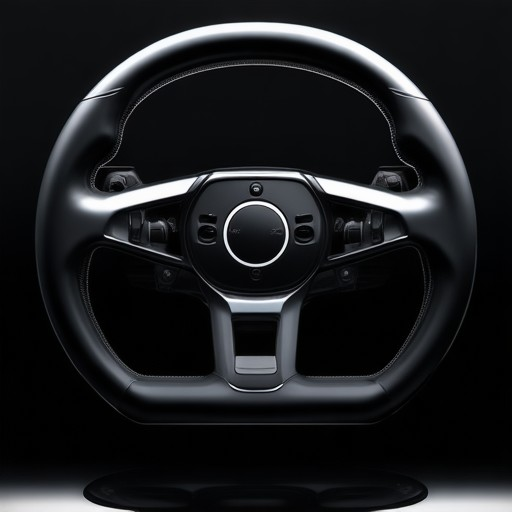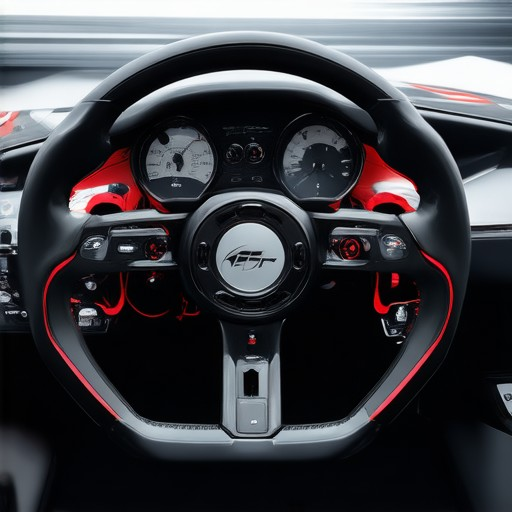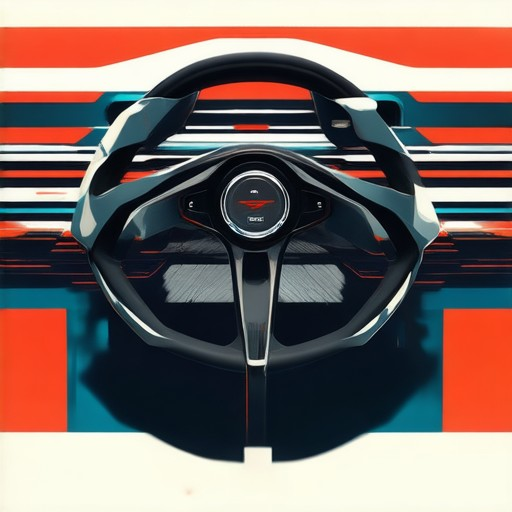The Ultimate Guide to the Perfect Racing Wheel Setup: Elevate Your Gaming Experience
When it comes to enhancing your gaming experience, especially in the realm of sim racing, a well-configured racing wheel setup is essential. Whether you’re a seasoned player or new to the world of SIM racing, understanding the right setup can make a significant difference in performance, comfort, and overall enjoyment. This guide delves into the key aspects of optimizing your racing wheel setup, ensuring you get the most out of your gaming sessions. From selecting the perfect SIM racing wheel to adjusting pedal controls and seat positioning, we’ll explore everything you need to know to achieve the ultimate racing experience.

Proper Steering Wheel Setting
The proper steering wheel setting varies depending on personal comfort, vehicle type, and driving conditions. Here are the key considerations:
- 10 and 2 Position: This is the most common starting point. Place your left hand at 10 o’clock and your right hand at 2 o’clock. This allows for better control and visibility, especially in traffic.
- 9 and 3 Position: A more relaxed alternative, where your left hand rests at 9 o’clock and your right at 3 o’clock. This can be comfortable for longer drives or when driving alone.
- Adjustments Based on Car Type: Sports cars or trucks may require a different grip due to their design. Ensure your seating position accommodates your grip for optimal control.
- Passenger Seat Adjustment: Allow enough space for the passenger to sit comfortably, promoting a more relaxed driving environment and reducing fatigue.
Ultimately, the best setting is one that feels natural and comfortable for you. Experiment with different positions to find what works best, considering factors like ergonomics and personal preference. For further details, explore our Steering Wheel Ergonomics Guide .
Best SIM Wheel for a Beginner
If you’re just starting out with sim racing, finding the right wheel can feel overwhelming. Here’s a breakdown of the best options available, tailored for beginners:
Overview
A good sim racing wheel should be comfortable, adjustable, and compatible with most platforms. Look for features like pedal adjustment, wheel height adjustment, and a sturdy construction.
Top Picks for Beginners
| Model | Price Range | Features | Why It’s Great for Beginners |
|---|---|---|---|
| Moza R5 Bundle | $299 – $399 | Adjustable Pedals, Comfortable Design, Durable Build | Perfect for those looking for a mid-range option with great ergonomics. |
| Gran Turismo DD Pro | $599 | High-End Construction, Realistic Feel, Advanced Features | Great for serious racers but still accessible for newcomers. |
| Cosworth FD V2 | $699 | Realistic Tires, Adjustable Height, Smooth Rotation | Excellent choice for those who want a premium feel without breaking the bank. |
Key Features to Consider
- Adjustability: Look for wheels with adjustable pedals and height to customize the fit.
- Compatibility: Ensure the wheel works with your gaming platform (PS4, Xbox, PC, etc.).
- Durability: A sturdy build means the wheel will last through intense racing sessions.
- Weight: A heavier wheel may offer better stability but can be less comfortable for shorter drives.
Why Choose Incubus Wheels?
At Incubus Wheels, we understand the importance of finding the perfect setup for your sim racing experience. Whether you’re just starting out or looking to upgrade, our selection of high-quality wheels offers something for everyone. Check out our full collection to find the ideal wheel for your needs.
Conclusion
Picking the best sim wheel for beginners really depends on your preferences and budget. The Moza R5 Bundle is an excellent all-around choice, while the Cosworth FD V2 offers a premium experience at a reasonable price. Whichever you choose, make sure to adjust the wheel to fit your driving style and enjoy the thrill of sim racing!

Setting Up a Racing Simulator
To build a professional-grade racing simulator, you’ll need a combination of hardware and software that mimics the experience of actual racing. Below is a breakdown of the essential components and tools required:
1. Computer Setup
- High-Performance PC : Ensure your system has a powerful GPU (preferably NVIDIA RTX 3080 or higher) and a capable CPU (Intel Core i7 or AMD Ryzen 7) to handle demanding simulations.
- Multiple Monitors : A triple-screen setup is ideal for immersive viewing, typically using 1080p or 1440p resolution with a high refresh rate (120Hz or higher).
2. Racing Seat
- Adjustable Ergonomic Seat : Opt for a seat designed for sim racers, such as those from Sparco or Logitech, to provide comfort and support during long sessions. These seats often feature adjustable height, lumbar support, and simulated G-force effects.
3. Pedal Set
- Precision Pedals : Invest in a pedal set like the Logitech G Pedals, which offers realistic feel and adjustability. Flat or sequential pedals are available depending on your preference.
4. Racing Wheels
- Realistic Wheelbase : Choose a high-quality wheel from brands like Fanatec or Thrustmaster. Look for models with adjustable wheelbases to accommodate different setups and weights.
5. Shifter (Optional)
- Manual Gear Shifting : For authenticity, consider adding a manual shifter, either hand-held or floor-mounted, to mimic real car transmission controls.
6. Gaming Controller (Optional)
- Console Compatibility : Use an Xbox One or PlayStation controller for console-based sims or a dedicated controller like the Logitech F310 for PC games.
7. Sim Racing Software
- Select a Platform : Choose from Assetto Corsa, Forza Horizon, Project CARS, or rFactor 2 based on your preferred realism level and platform (PC, Xbox, PlayStation).
8. Steering Wheel Hub (Optional)
- Wireless or Wired Connection : Attach a Logitech steering wheel hub to your monitor for added realism and functionality, allowing for adjustments like tilt sensitivity.
9. Accessories and Customization
- Add-Ons : Enhance your setup with trim rings, LED lighting, and a drink holder for an authentic cockpit feel.
- Cooling Solutions : Install fans or a liquid cooling system to manage heat generated by your PC during extended use.
10. Peripherals
- Headset/Microphone : Ensure clear communication with teammates by using a compatible headset or microphone.
11. Desk or Simulator Mount
- Sturdy Base : Secure your setup on a solid desk or invest in a dedicated simulator desk to minimize movement and fatigue.
12. Environmental Considerations
- Quiet Space : Set up your simulator in a quiet room to reduce external distractions. Consider acoustic panels if noise is an issue.
Software Configuration Tips
- Tune Settings : Customize your simulation software to match your hardware, adjusting parameters like tire models, suspension dynamics, and driving aids for optimal realism.
By assembling these components thoughtfully, you can create a racing simulator that delivers an immersive and authentic experience, whether for casual gaming or competitive racing.

How to Position a Racing Wheel
To position a racing wheel correctly, follow these essential steps for optimal ergonomics and performance:
- Determine the Ideal Height : Position the wheel at approximately shoulder height. This allows for comfortable control without excessive strain during long races.
- Adjust the Tilt Angle : Set the wheel with a slight forward tilt (typically between 0 and 30 degrees) to shift weight forward, enhancing cornering grip.
- Center the Wheel : Ensure the wheel is centered beneath the driver’s seat for stability and balanced handling. Avoid positioning it too far left or right to prevent issues with visibility and control.
- Seat and Wheel Alignment : Adjust the seat height and position in conjunction with the wheel setup to ensure proper reach and alignment. A misaligned seat can hinder performance and comfort.
- Steering Column Angle : Choose a steering column angle that offers a balance between speed and neck strain. Steeper columns may offer quicker movements but require careful adjustment for comfort.
- Secure the Wheel Mounting : Safely mount the wheel on the steering column using the correct hardware and torque settings to prevent movement during driving.
- Consider Accessories : Explore optional accessories like wheel extensions or supports to tailor the setup to personal preferences or specific racing needs.
By focusing on these ergonomic adjustments and proper installation, drivers can create a racing wheel setup that maximizes comfort and performance.
Ideal Racing Wheel Setup for Optimal Control and Comfort
For optimal control and comfort in racing scenarios, the setup of your racing wheel is crucial. Here’s a breakdown of essential considerations:
- Wheel Offset (ET): Aim for a higher offset, typically between 8-12mm, to enhance cornering grip and stability.
- Wheel Width: Choose a width of 7-9 inches for a balance between grip and handling responsiveness.
- Tire Size: Opt for 205-315mm diameter tires for excellent grip, ensuring they fit well within the wheel arches.
- Suspension Setup:
- Adjust ride height for optimal aerodynamics vs. ground clearance, balancing comfort and performance.
- Select spring rates that offer a comfortable yet supportive feel without sacrificing stability.
- Fine-tune dampeners for a smooth ride and precise handling under acceleration/deceleration.
- Toe Angle: Set toe-in for improved turn-in response and stability, adjusting based on track characteristics.
- Dampening and Anti-Roll Bars: Calibrate these to complement your suspension setup, enhancing body control without harshness.
- Weight Reduction: Minimize unnecessary weight to improve acceleration and handling efficiency.
- Driver Comfort: Ensure proper seat positioning, support, and ergonomic layout for extended driving sessions.
- Track Conditions: Adapt your setup according to the track’s surface and conditions, adjusting for grip and stability needs.
Remember, the perfect setup is often found through testing and adjustment. Start with a baseline configuration and refine it based on real-world feedback and performance changes. Prioritize a balance between control and comfort to maximize your racing experience.

Optimal Racing Wheel Setup for Enhanced Control and Comfort
When fine-tuning your racing wheel setup, balancing control and comfort is essential for maximizing performance during extended gaming sessions. Here’s a comprehensive guide to achieving the perfect configuration:
1. Wheel Size and Weight
- Wheel Size : Choose a size that offers a balance between precision and ergonomics. A medium size (e.g., 24cm diameter) often strikes a sweet spot, providing enough surface area for accuracy without compromising comfort.
- Weight : Opt for a mid-range weight that complements your gaming chair. A heavier wheel may offer better stability but could lead to fatigue, while a lighter wheel enhances responsiveness but may lack durability.
2. Pedal Position Adjustment
- Forward Placement : Position the pedals slightly forward to align with your natural foot placement, reducing strain on your wrists and forearms.
- Height Adjustment : Fine-tune the pedal height to match your desk level, ensuring your elbows remain at a comfortable angle during prolonged use.
3. Tension and Resistance Settings
- Tension : Start with a medium tension setting. Too loose, and the wheel becomes unresponsive; too tight, and it feels awkward to use.
- Resistance : Adjust the resistance to suit your playstyle. A smoother surface reduces wear and tear on your hands while maintaining control.
4. Comfort Enhancements
- Ergonomic Design : Select a wheel with an adjustable grip and cushioned pedal surfaces to reduce fatigue.
- Seat Alignment : Ensure your chair is positioned correctly, with your back straight and hips aligned with the wheel’s height.
- Grip Type : Choose a grip style that suits your preferences—thicker grips for better control or thinner grips for a more relaxed feel.
5. Additional Tips for Extended Gaming Sessions
- Regular Breaks : Take short breaks every 30 minutes to stretch and maintain circulation.
- Posture Awareness : Use a comfortable chair and consider a supportive seat cushion to prevent slouching.
- Footrest : Utilize a sturdy footrest to distribute body weight evenly and reduce strain on your legs.
Conclusion
By thoughtfully adjusting your racing wheel setup, you can optimize both control and comfort during extended gaming sessions. Prioritize a balanced wheel size, ergonomic adjustments, and proper seating alignment to enhance your overall experience. Remember, the best setup is one that feels natural and allows you to perform at your peak without discomfort.




0 Comments